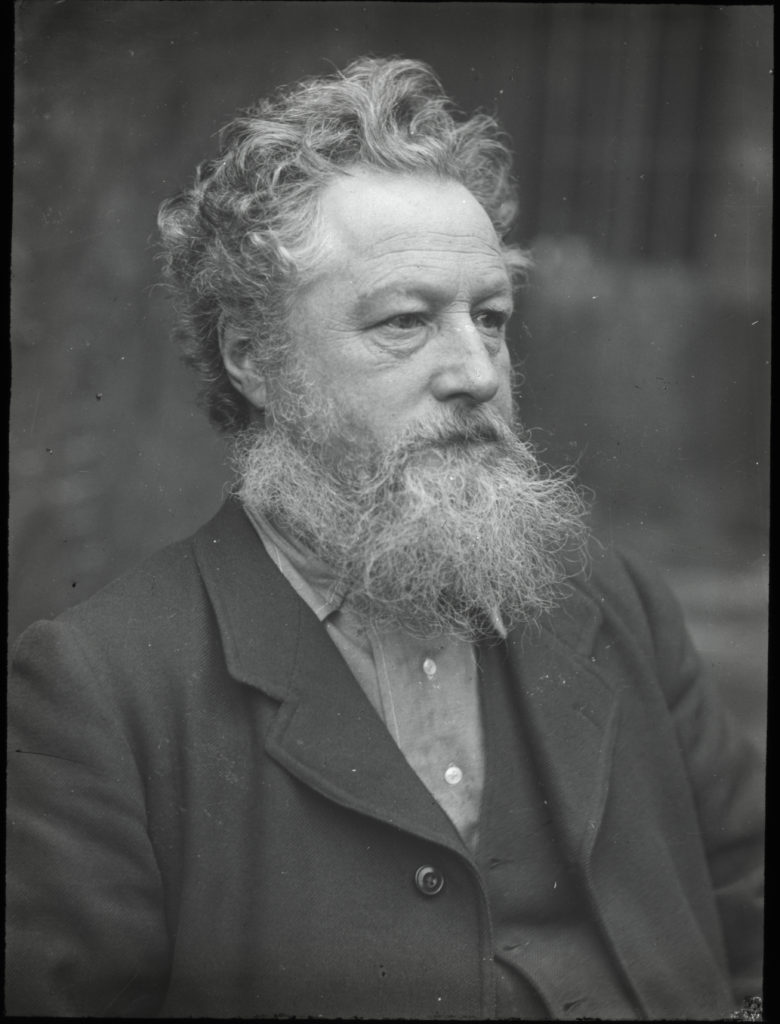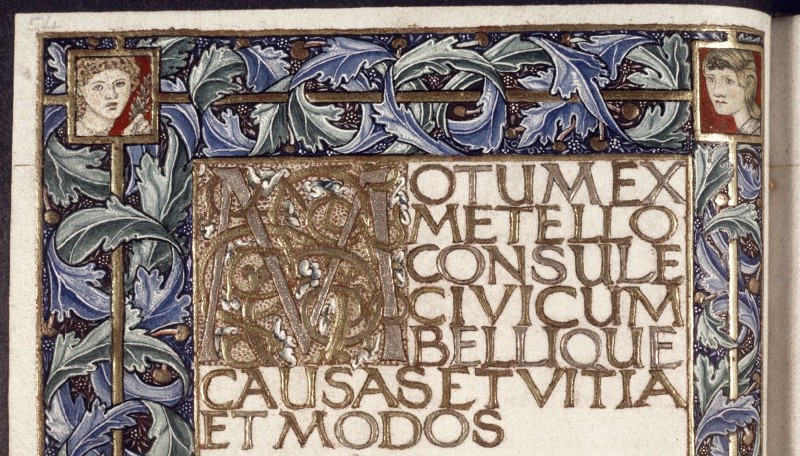Chiswick Timeline of Writers & Books: A Quick Guide
The writer, designer, artist and socialist activist William Morris is widely seen as the father of the Arts and Crafts movement.
He is closely associated with Hammersmith, where he lived at Kelmscott House, 26 Upper Mall, W6 9TA, from 1879 until his death in 1896.
The Coach House is the headquarters of the William Morris Society and is open to visitors on Thursday, Saturday and Sunday afternoons.
A special exhibition ran there till October 2019. Read more at the website Arts & Crafts Hammersmith.
Before he moved to Kelmscott House, Morris lived in Chiswick for six years.
Image below: William Morris 1889 (aged 54 ) taken by Emery Walker, Collection of The William Morris Society

1. From Gill Clegg’s Chiswick History Web Pages:
Between 1872 and 1878, when he moved to Kelmscott House, Hammersmith, William Morris (1834-1896) was renting Horrington House in Chiswick High Road, near to where Thornton Avenue is today. He was thus close to Bedford Park which was in the process of being built. Although the new estate’s design was influenced by the Arts and Crafts Movement, of which Morris is the acknowledged father, Morris is said to have been ambivalent towards Bedford Park.
2. Fiona MacCarthy in her biography of Morris, A Life for Our Time, describes his life in Chiswick:
Horrington House (was) ‘a very little house with a pretty garden’ on Turnham Green Road, the main road running between Turnham Green and Hammersmith. Philip Webb called it ‘the little shed on the high road’… (Now demolished, it) does not seem to have been environmentally ideal, standing alongside the Roebuck pub where the Hammersmith omnibuses stopped.
But Chiswick at that time was still a roomy, pleasant suburb of fine houses and large orchards; you could smell and feel the river air down Chiswick Lane. Market wagons packed with produce would trundle down the High Road, and Horrington House soon acquired a certain cosiness. Margaret Burne-Jones associated it for ever afterwards with ‘quantities of crumpets’. The kitchen was inhabited by a large yawning cat called Jack. The house served its purpose: the family had settled in in January 1873. They later renewed the lease. In all they stayed there for six years.
Morris came to like Horrington House much more than expected, finding his workroom there brighter and more relaxing than his dingy study in Queen Square. Indeed a vision of contentment of those years was to be in his ‘pretty room at Turnham Green reading some hitherto unprinted Dumas say about as good as the 3 Musketeers’. He was still writing and illuminating manuscripts. This was his chief enjoyment at that period.

George Price Boyce, visiting him at his new house, found him at work on the vellum inscription of The Odes of Horace (image above), the relatively small-scale and exquisitely detailed, flowing, floriated version that is now the prize of the Morris manuscripts in the Bodleian. (Read more and see images here). Jenny and May were with their father and struck Boyce as ‘very interesting little things, very handsome’. In the course of that visit Rossetti too came in.
For the children, and their friends, Morris’s workroom in the little house in Chiswick was a place of long-remembered fascination, with the gold leaf and the ox-gall, the ‘very little pots of dye stuffs’ and the hanks of worsted which hung around the room. The table in the study was a centre of attraction around which the girls would tiptoe in awe and admiration, not daring to touch the tools and the equipment so professionally arrayed. Morris illuminating: ‘the bare light room, the plain work-table; the splendid head bending over the gold, and the two young heads laid close, and the curly locks all mingling’. This was one of the images of childhood May dared to keep intact.
3. Morris’s authorised biography The Life of William Morris, written by JW Mackail (son in law of Edward Burne-Jones), describes an encounter at Chiswick Club Hall:
Morris, having given a lecture to further the socialist cause at the Chiswick Club Hall is quoted as saying, “I lectured in the Chiswick Club Hall and had a scanty audience and a dull. It was a new lecture, and good, though I say it, and I really did my best; but they hung on my hands as heavy as lead.”
4. Morris’s younger daughter May Morris was an influential designer and Director of the Embroidery Department at her father’s enterprise Morris & Co. She edited her father’s Collected Works in 24 volumes.
5. Morris & Co is now part of the Sanderson Design Group, which also has strong Chiswick connections. Read more on the Morris & Co website and on this page of the Timeline, Arthur Sanderson and Chiswick Library.
Read more stories via the Writers Tales page.
